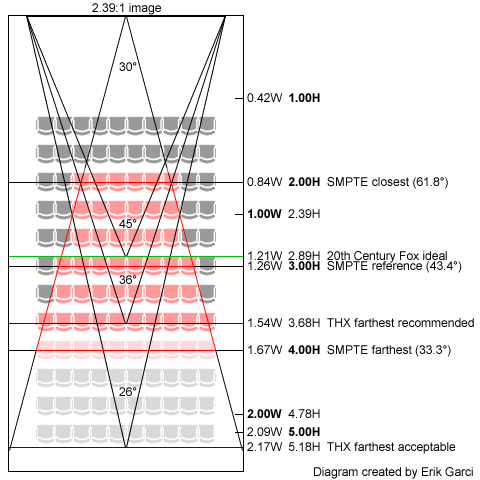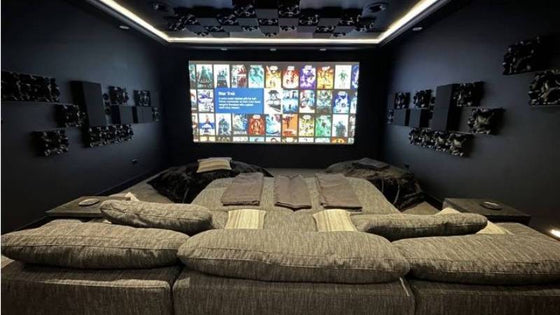Creating a system you love shouldn't be difficult. The Acoustic Frontiers blog is here to help.

The horizontal viewing angle is the angle subtended by a straight line from each side of the screen to the seating position. The main two standards in the commercial world are the SMPTE and THX specifications as summarized in the diagram below:

New cinemas built to THX specifications have a minimum viewing angle of 36 degrees from the last row of seats. The viewing angle ‘sweet spot’ seems to be around 45-50 degrees where SMPTE, THX and 20th Century Fox recommendations converge. This matches quite closely with CEDIA’s 43 degree viewing angle recommendation for 2.4:1 ‘Cinemascope’ content as per CEB-23. For reference 43 degrees is 3x picture height using a 2.35:1 screen.
Depending on where you like to sit in a commercial theater you might have a viewing angle of anywhere from 36 to 60 degrees. Personal preference is therefore an important factor and should be a prime consideration when laying out your home theater.
Visual acuity data give us useful information about when a person should be able to appreciate the full benefit of different resolutions.
Higher resolutions should allow us to sit closer to the screen for a more immersive experience. Likewise with lower resolutions we may want a smaller viewing angle so that deficiencies in the source’s resolution are not overly exposed.
The CEDIA recommendation, which is based on SMPTE guidance, is or no viewer to have an angle of greater than 15 degrees to the top or bottom of the screen. Typically this puts viewers eye’s at 1/3rd to 1/6th of screen height.
In larger home theaters multiple rows of seats are common. This introduces some compromises and challenges:
Need help laying out your home theater screen and seating locations for proper viewing angles? Contact us now!
Learn how early home theater design, layout, and acoustic treatment improve performance in new home construction.
This media room was intentionally designed to feel like part of the home—not a separate, tech-heavy space. Through careful acoustic planning, equipment integration, and final calibration, we achieved a room that is both beautiful to live in and immersive to experience.
"No other subwoofer system I’ve owned even comes close to what this room delivers. Reaching out to Acoustic Frontiers was one of the best decisions I’ve made—I highly recommend working with them if you want to get the most out of your theater."

Nyal Mellor, Founder, Acoustic Frontiers



Nyal Mellor
Author